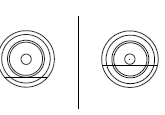Driving through water

If driving through deep or standing water is unavoidable, proceed very slowly. Never drive through water that is higher than the bottom of the wheel rims (for cars) or the bottom of the hubs (for trucks).

When driving through water, traction or brake capability may be limited.
Also, water may enter your engine’s air intake and severely damage your engine or your vehicle may stall. Driving through deep water where the transmission vent tube is submerged may allow water into the transmission and cause internal transmission damage.
Once through the water, always dry the brakes by moving your vehicle slowly while applying light pressure on the brake pedal.
Wet brakes do not stop the vehicle as quickly as dry brakes.
See also:
Compass zone adjustment
Compass zone adjustment
1. Determine which magnetic zone
you are in for your geographic
location by referring to the zone
map.
2. Turn ignition to the on position.
3. Press and hold t ...
Important supplemental restraint system precautions
Airbags DO NOT inflate slowly or
gently and the risk of injury from a
deploying airbag is greatest close to
the trim covering the airbag module.
WARNING: All occupants of the vehicle, includi ...
Battery saver
The battery saver will shut off the lamps 10 minutes after the ignition
has been turned off.
• If the dome lamps were turned on using the panel dimmer control, the
battery saver will shut them ...
